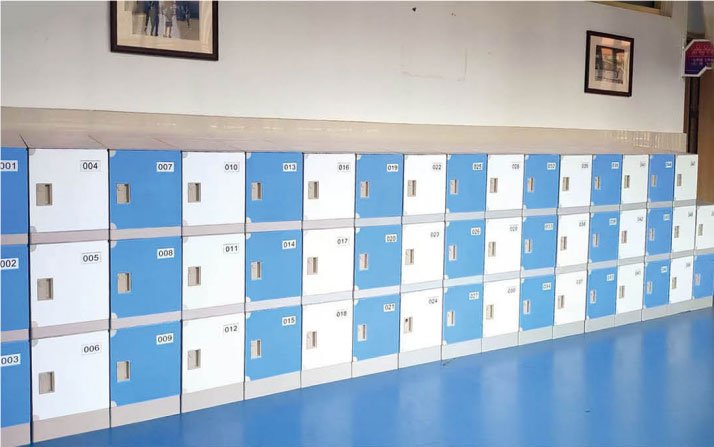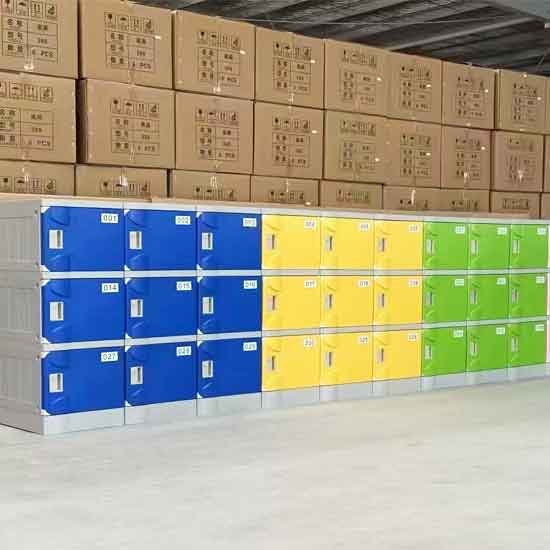Ultimate Guide to Choosing Waterproof ABS Lockers for Gym Changing Rooms: Durability Meets Functionality
In the competitive fitness industry, every detail matters—from the equipment you offer to the amenities you provide. Among these essential amenities, gym lockers play a pivotal role in member satisfaction and retention. Waterproof ABS lockers have emerged as the gold standard for modern gym changing rooms, offering unparalleled durability, functionality, and aesthetic appeal. This comprehensive guide will walk you through everything you need to know about selecting the perfect waterproof ABS lockers for your fitness facility, ensuring you make an informed decision that enhances both member experience and operational efficiency.
Understanding ABS Material: Why It’s Superior for Gym Environments
Before diving into selection criteria, it’s essential to understand why ABS (Acrylonitrile Butadiene Styrene) has become the preferred material for gym lockers in contemporary fitness facilities.
The Science Behind ABS Durability
ABS is a thermoplastic polymer known for its exceptional strength-to-weight ratio and impact resistance. Unlike traditional metal lockers that can dent, rust, or corrode in humid environments, ABS maintains its structural integrity even under challenging conditions:
- Water Resistance: ABS is inherently waterproof, making it ideal for the high-moisture environment of gym changing rooms where humidity levels can fluctuate dramatically.
- Impact Resistance: The material can withstand significant force without denting or cracking, ensuring your lockers maintain their appearance despite heavy daily use.
- Chemical Resistance: ABS resists damage from cleaning chemicals, deodorants, and other substances commonly found in gym environments.
- Temperature Stability: The material maintains its properties across a wide temperature range, preventing warping or distortion in varying conditions.

Long-Term Cost Benefits
While the initial investment in ABS lockers may be higher than some alternatives, the long-term financial benefits are substantial:
- Reduced Replacement Costs: ABS lockers typically last 15-20 years, compared to 5-10 years for metal alternatives, significantly reducing replacement frequency.
- Lower Maintenance Requirements: Unlike metal lockers that may require rust treatment or repainting, ABS lockers need minimal maintenance beyond regular cleaning.
- Energy Efficiency: ABS lockers don’t conduct heat or cold as readily as metal, potentially reducing climate control costs in your changing room area.
Key Selection Criteria for Waterproof ABS Gym Lockers
Size and Configuration Considerations
When selecting ABS lockers for your gym, size and configuration are paramount to optimizing space and meeting member needs. Based on industry standards and member preferences, consider the following specifications:
Standard Dimensions:
- Single Compartment: 930mm (H) × 320mm (W) × 420mm (D) – Ideal for storing gym bags, clothing, and personal items
- Multi-Unit Configuration: 1940mm (H) × 960mm (W) × 420mm (D) for a 6-door unit – Maximizes vertical space while maintaining accessibility
Capacity Planning:
- Peak Usage Analysis: Calculate your maximum simultaneous locker usage based on membership numbers and peak attendance times
- Member-to-Locker Ratio: Industry standards suggest a ratio of 1:3 to 1:5 (lockers to members), depending on your gym’s business model
- Future Growth Considerations: Plan for 20-30% additional capacity to accommodate membership growth without requiring immediate expansion
Color Options and Aesthetic Integration
The visual appeal of your lockers significantly impacts the overall atmosphere of your changing room. Modern ABS lockers offer extensive color customization to align with your gym’s branding and design aesthetic:
Available Color Options:
- Neutral Tones: White, Gray, and Wood finish – Versatile options that complement any design scheme
- Cool Tones: Blue, Light Blue, Green, and Fruit Green – Create a calming, refreshing atmosphere
- Warm Tones: Pink, Yellow, and Orange – Add energy and vibrancy to your space
Design Integration Strategies:
- Brand Alignment: Select colors that match or complement your gym’s logo and brand identity
- Psychological Impact: Consider color psychology – blues and greens promote calmness, while warmer tones energize
- Maintenance Considerations: Lighter colors may show dirt more readily but make the space feel larger and brighter
Essential Features and Configurations
Core Functionality Elements
When evaluating ABS lockers for your gym, certain features are non-negotiable for ensuring member satisfaction and operational efficiency:
Security Features:
- Robust Locking Mechanisms: Look for lockers with reliable, easy-to-operate locks that can withstand repeated use
- Ventilation Design: Proper ventilation prevents odor buildup and allows damp items to dry
- Structural Integrity: Ensure the locker construction can support the weight of typical gym items without sagging or distortion
User Experience Enhancements:
- Ergonomic Handles: Comfortable, easy-to-grip handles that accommodate users of all ages and abilities
- Smooth Operation: Doors and drawers should open and close smoothly without jamming or sticking
- Accessibility Considerations: Design features that accommodate users with mobility challenges or special needs
Advanced Configuration Options
Modern ABS lockers offer various configuration options that can significantly enhance functionality and user experience:
Standard Configuration Features:
- Numbered Door Plates: Essential for organization and easy identification of individual lockers
- Towel Bars: Integrated towel holders provide convenience for members and encourage proper towel storage
- Storage Compartments: Additional small storage areas within lockers for valuables or smaller items

Customization Possibilities:
- Digital Integration: Options for electronic locks with membership card integration or mobile app control
- Charging Stations: Built-in USB ports or power outlets for charging electronic devices
- Specialized Compartments: Customizable storage solutions for specific items like shoes, wet clothing, or valuables
Installation and Maintenance Best Practices
Strategic Installation Planning
Proper installation is crucial to maximizing the functionality and longevity of your ABS lockers:
Space Optimization:
- Traffic Flow Analysis: Arrange lockers to facilitate smooth movement through the changing area, especially during peak times
- Accessibility Considerations: Ensure adequate space between locker rows for comfortable access, particularly for users with mobility challenges
- Ventilation Planning: Position lockers to maximize air circulation and minimize moisture accumulation
Installation Requirements:
- Floor Preparation: Ensure a level, stable surface that can support the weight of fully loaded lockers
- Wall Anchoring: Properly secure lockers to walls to prevent tipping and ensure stability
- Utility Integration: Plan for electrical needs if incorporating digital locks or charging stations
Maintenance Protocols for Longevity
Establishing proper maintenance procedures will extend the life of your ABS lockers and maintain their appearance:
Regular Cleaning Procedures:
- Daily Maintenance: Wipe down surfaces with mild soap and water to remove sweat, dirt, and bacteria
- Weekly Deep Cleaning: More thorough cleaning with appropriate disinfectants to maintain hygiene standards
- Seasonal Inspections: Check for any signs of wear, damage, or needed repairs
Preventative Maintenance Measures:
- Hardware Checks: Regularly inspect and tighten hinges, handles, and locking mechanisms
- Ventilation Maintenance: Ensure ventilation systems remain clear and functional
- Damage Documentation: Keep records of any repairs or replacements to track locker performance over time
Making the Final Decision: A Step-by-Step Approach
Assessment and Planning Phase
Before making your purchase, thorough assessment and planning are essential:
Needs Analysis:
- Member Demographics: Consider the age range, physical abilities, and preferences of your membership base
- Usage Patterns: Analyze when and how frequently lockers are used to determine optimal capacity and configuration
- Space Constraints: Measure your changing room area carefully, accounting for traffic flow and other amenities
Budget Considerations:
- Initial Investment: Determine your available budget for the locker purchase and installation
- Long-Term Value: Consider the total cost of ownership, including maintenance and expected lifespan
- Return on Investment: Calculate how quality lockers might impact member retention and satisfaction
Vendor Selection and Purchase Process
Choosing the right vendor is as important as selecting the right lockers:
Vendor Evaluation Criteria:
- Product Quality: Assess the materials, construction, and warranty offerings
- Customization Options: Determine the vendor’s ability to meet your specific color and configuration needs
- Installation Services: Evaluate whether the vendor provides professional installation and support
Purchase Process Best Practices:
- Request Samples: Obtain physical samples to evaluate quality, color accuracy, and construction
- Check References: Speak with other gym owners who have purchased from the vendor
- Review Contract Terms: Carefully examine warranty terms, delivery timelines, and payment schedules
Selecting the right waterproof ABS lockers for your gym changing room is more than a functional decision—it’s an investment in your members’ experience and your facility’s reputation. By carefully considering material quality, size requirements, color options, and essential features, you can create a changing room environment that enhances member satisfaction, promotes loyalty, and sets your gym apart from competitors.
Remember that quality lockers communicate your commitment to excellence in every aspect of your facility. They demonstrate attention to detail, concern for member comfort and security, and an understanding of the unique challenges of the gym environment. By following the guidelines outlined in this comprehensive guide, you’ll be well-equipped to make an informed decision that serves your gym’s needs for years to come.
